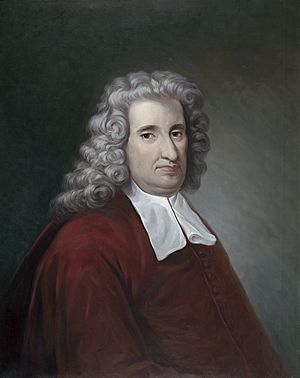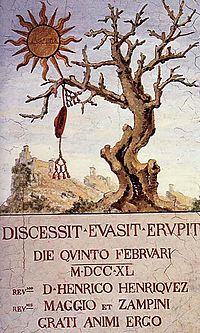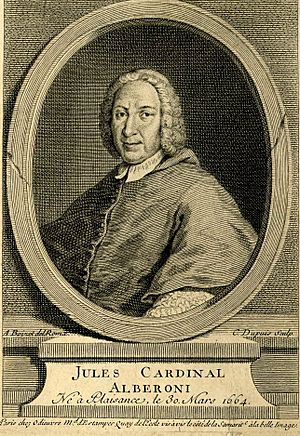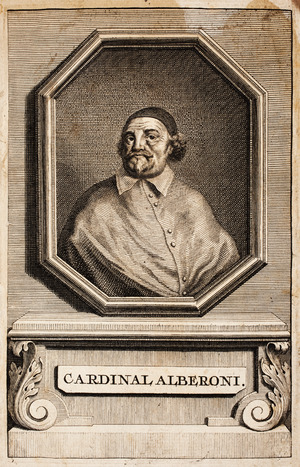Giulio Alberoni facts for kids
Giulio Alberoni (born in 1664, died in 1752) was an important Italian cardinal and a smart politician. He worked for Philip V of Spain, who was the King of Spain.
Contents
Early Life and Rise to Power
Giulio Alberoni was born in a small village called Fiorenzuola d'Arda near Piacenza in Italy. His father was a gardener, so Giulio came from a simple family.
He started working for the church as a bellringer and verger in the main church of Piacenza. When he was about 21, he met a judge named Ignazio Gardini. Giulio followed Gardini to another city, where he met a church official named Giorgio Barni. Barni later became the bishop of Piacenza and hired Alberoni to work for him. Alberoni then became a priest.
During a big war called the War of the Spanish Succession, Alberoni helped the French army commander, Louis-Joseph, duc de Vendôme. The duke of Parma sent Alberoni to help him. When the French army went back to France in 1706, Alberoni went with the duke to Paris. The French King, Louis XIV, liked him.
Becoming a Powerful Statesman
Alberoni later went to Spain with the French commander as his secretary. He worked hard to support Philip V becoming the King of Spain. After the commander died, Alberoni became a Count in 1713. He also became an agent for Parma at Philip's court and was a favorite of the King.
A peace treaty called the Treaty of Utrecht was signed in 1713. This treaty made Philip King of Spain, but Spain lost some of its lands. For example, parts of the Southern Netherlands and Italian lands went to Austria and Savoy. Britain gained Menorca and Gibraltar, and British traders got new rights to trade in the Spanish Americas.
At this time, a powerful woman named Marie-Anne de la Trémoille was very influential in the Spanish court. She had a lot of control over King Philip and his wife, Maria Luisa. Alberoni worked with her. When Maria Luisa died in 1714, Alberoni and Marie-Anne arranged for King Philip to marry Elisabetta Farnese, who was the daughter of the Duke of Parma.
Elisabetta was a strong person herself. She quickly formed an alliance with Alberoni. Their first action together was to send Marie-Anne de la Trémoille away from the court. By the end of 1715, Alberoni had become very powerful. He was made a Duke and a Grandee of Spain, which is a very high noble title. He also became a member of the King's council, the Bishop of Málaga, and the Chief Minister of Spain. In 1717, the Pope made him a Cardinal.
Improving Spain's Economy
After the war, Spain's government changed to be more like France's, with more power in the King's hands. This allowed Alberoni to make many changes to help Spain's economy. He removed taxes between different regions in Spain and encouraged more trade with the Spanish colonies in the Americas. He also set up a regular mail service to the colonies and improved how the government managed its money. He even created a new school for navigation, especially for the sons of noble families.
Spain's Military Actions
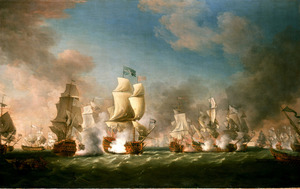
These changes made Spain feel strong enough to try and get back lands it had lost in Italy. In 1717, a Spanish army took over Sardinia without a fight. At that time, Austria and Savoy, who owned these lands, didn't have strong navies, and Austria was busy fighting another war. Spain thought Britain would not get involved.
However, when 38,000 Spanish soldiers landed on Sicily in 1718, Britain saw this as breaking the peace treaty. On August 2, 1718, Britain, France, the Netherlands, and Austria formed an alliance called the Quadruple Alliance. Just nine days later, on August 11, the British Royal Navy destroyed a Spanish fleet near Sicily in the Battle of Cape Passaro.
Alberoni tried to get back at Britain by supporting a plan for a Scottish uprising against the British King. He also tried to break the alliance between Britain and France. However, he didn't realize how strong Britain's navy had become. France declared war on Spain in December 1718.
French forces invaded eastern Spain, and in October 1719, a British naval group captured the Spanish port of Vigo. They landed 6,000 soldiers, held Vigo for ten days, destroyed many supplies, and then left without any problems. This showed Spain that Britain could land anywhere along their coast and leave whenever they wanted. Because his plans failed, Alberoni was removed from his position on December 5, 1719, and told to leave Spain. A new treaty in 1720 confirmed the results of the earlier peace treaty.
Later Life and Legacy
After leaving Spain, Alberoni went back to Italy. He had to hide for a while because the Pope at the time, Pope Clement XI, was his enemy and wanted him arrested. But when Clement died in 1721, Alberoni bravely showed up at the meeting to choose the next Pope and even helped choose Pope Innocent XIII. At the next election for Pope in 1724, Alberoni himself was suggested for the job and received ten votes!
The next Pope, Clement XII (chosen in 1730), made Alberoni a special representative in Ravenna. There, Alberoni built a beautiful gate called the Porta Alberoni in 1739.
Later, Pope Clement XII appointed him to manage a hospital in Piacenza called San Lazzaro. This hospital was originally for people with leprosy, but by then, leprosy had almost disappeared in Italy. Alberoni got permission from the Pope to close the old hospital, which was in bad shape. In its place, he founded a school for poor boys who wanted to become priests. This school was named the Collegio Alberoni, and it still exists today. Cardinal Alberoni also had a large collection of art, including famous paintings and tapestries, which are now part of the Collegio's collection.
Alberoni loved good food! In his letters, he often asked for local treats like truffles, salame, and special cheeses. A pork dish from Piacenza called "Coppa del Cardinale" is named after him. There's also a dish called "timballo Alberoni" that combines macaroni, shrimp sauce, mushrooms, butter, and cheese.
Death
Giulio Alberoni died in 1752. He left a large sum of money to help the school he founded, the Collegio Alberoni. He left the rest of his great wealth, which he had gained in Spain, to his nephew.
See also
 In Spanish: Giulio Alberoni para niños
In Spanish: Giulio Alberoni para niños


